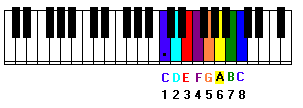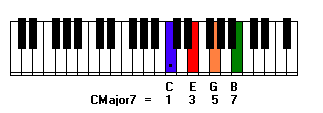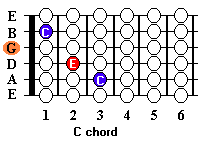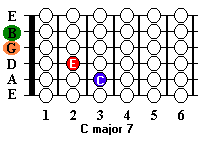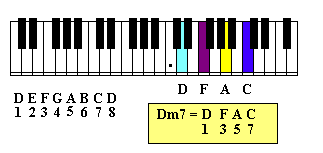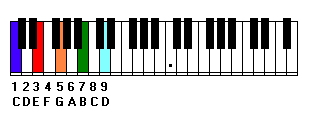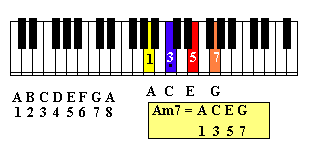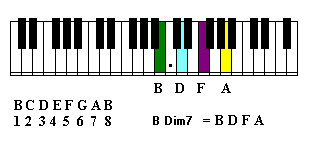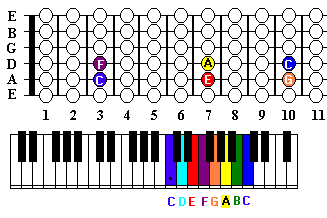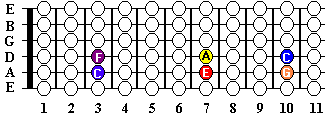 |
A Visual Learning Experience, Lead Guitar Made Easy
Includes Over 150 online guitar lessons - Become a member today!
Welcome to Guitar Secrets
Guitar lessons that work!
Constructing 7th Guitar Chords
By the time we get done with the next couple lessons there will be no need for those chord finder things. The most important skill to obtain is chord theory, which includes chord construction. You must understand how chords relate to each other and how they are constructed before we can completely understand chord substitution. In this lesson and the next few we will work on constructing 3 and 4 note chords. We will construct major and minor 7th chords and much more.
You may be wondering why I'm using a piano keyboard; the piano keyboard will help me illustrate chord construction.
The keyboard above illustrates the notes that make up the key of C major. Each note of the key of C major is numbered 1 through 8. Check those notes out and their placement. Notice that none of the black keys are used to construct the key of C major. The black keys are sharps and flats that will be used to construct chords and other scales.
So all the white keys on the keyboard are used to construct the key of C major. Notice that there is no black key between the E and F note and the B and C note. The distance from the B to C note would be 1/2 step. On the guitar that would equal 1 fret. Notice the distance from the C to D note, there is 1 black key in between these two notes. That black key would be 1/2 step and 1/2 step from the black key to the D note. This means that from the C to D we would have 1 whole step. 1 whole step on the guitar equals two frets. All of the notes other than the E and F and B and C are one whole step away from each other.
Remember from our scale construction lesson earlier that every major key is constructed with the W, W, H, W, W, W, H formula. W = whole step or 2 frets. H = 1/2 step or 1 fret. If you're not up on scale construction, it may be a good idea to go back and review major scale construction and chord construction.There's a very important reason why each note below has been numbered. We will construct our chords using the numbers under each of the chords.
Notice that the C note has the number 1 under it, the D is 2, E is 3 and so on. The C note with the 8 is one octave away from the first C note.
Recall in our major scale construction lesson that guitar chords are built upward in 3rds. The major guitar chord (Triad 3 note chord) is constructed with the 1st, 3rd and 5th notes. Look above and notice the 1st, 3rd and 5th notes, these are the C E and G notes. These are the notes that make up the C guitar chord.
We can now use this technique to build any triad in the key of C major we want to. But more important we can use this technique to construct any type of chord we need. As our lessons advance, we will learn how to determine whether the notes of each chord have a minor 3rd or a major 3rd. The major chord is built with a 1, 3 and 5, but the minor chord is built using the 1, b3 and 5. We don't have to worry about this with the technique below, but remember the major chord is built with the 1, 3 and 5 notes and the minor chord is built with 1, flat 3, 5 notes.
For example, the A major chord uses the notes: A, C# and E notes. The A minor chord used the notes A, C and E. Notice the 3rd note C is sharp in A major but not in A minor.
Since chords are build upward in 3rds we should be able to add one more note to the C chord and construct the C major 7th chord. If we added the 7th note in the key of C major, to the C chord C E G we would have C E G and B. These are the notes of the C major 7th chord.
The notes of the C major 7 chord are now illustrated. Notice we used the 1st, 3rd, 5th and 7th notes.
Now look below and compare the C chord top illustration to the C major 7 chord bottom illustration. One way to play the C major 7 chord is to remove your 1 finger from the C chord and play the open B string. Strum the C chord and then lift that 1 finger from the C note B string and strum the C major 7 chord. You may already know how to play these chords and that would be great, but learning how to construct each chord is equally or even more important. If you like to use the tapping technique, then this lesson will really increase your knowledge in that subject. How would you like to tap any chord you wanted to? By learning how to construct each chord, you can then tap them in any position.
You can now tap the C chord and then the C major 7 chord. We will eventually get to tapping and tons of other things. Once again, I would like to explain the chords in the key of C major. There are 3 major chords, 3 minor chords and a diminished chord in the key of C major. I really should say, you will find each of these chords in every major key. Every major key will have 3 major, 3 minor and 1 diminished chord. Knowing this, we can then construct each of these chords into some type of 7th chord. So far we have constructed the C chord and the C major 7.
Since there are 3 major guitar chords in the major key we should be able to construct another major 7 chord in the key of C major. Recall that the chords in the key of C major are as follows: C, Dm, Em, F, G, Am and B diminished.
The F and G chords are major chords in the key of C major. We can construct the F chord as we did the C chord and end up with a F major 7 chord. We can construct the G chord too, but it would not be a major 7 chord, but a Dominant 7 chord. I will explain this difference later on down the road. But recall from our earlier lessons in leading to modulation, the 1 chord was the tonic, the 4 chord the sub dominant and the 5 chord the dominant.
Since there are 3 minor chords in each major key, we can construct 3 minor 7 chords. This will be accomplished in the same fashion as the C major 7.
Once again the chords in the key of C major are C, Dm, Em, F, G, Am and B diminished. We will now construct the Dm7 chord. The Dm chord is made up of the notes D, F and A. Once again we will use the same technique as we used for the C chord. This time we will write out the notes in key of C major, but start with the D note. Look to the left and notice that the D note is now the 1 note. Chords are built upward in 3rds, so the 1st, 3rd, 5th and 7th notes would construct the Dm7 chord. The 1st, 3rd and 5th would construct the Dm chord.
Are you starting to see the big picture here? We can add more notes and construct other chords in the same fashion. For example, if we add another note to the 7th chord, we could construct the 9th too.
The illustration below shows the notes, C, E, G, B and D.
1-3-5-7-9 would be the notes of the the C 9th chord. We can use this technique to construct any chord we want.
We will now construct the Am7 chord. The first thing you do is write out the notes in the key of C major and this time start with the A note as the 1st note. The notes that make up the Am chord are A, C and E. Once again the 1st, 3rd and 5th. We now add the 7th note and we have the Am7. A, C, E, and G. Recall that Am is the natural minor scale in the key of C major. There are three minor chords in each key and you would use this technique to construct each of them.
The illustration below shows the B diminished 7 chord. The B diminished chord is also referred to as the Bmb5 chord. It has been constructed the same as all the other chords. 1, 3, 5 and 7.
As our lessons advance, we will learn how to determine whether the notes of each chord have a minor 3rd or a major 3rd. The major chord is built with a 1, 3 and 5, but the minor chord is built using the 1, b3 and 5.
In this lesson we are going to get our fretting hand in shape. Not only will this exercise increase our strength and speed, it will open your eyes to tapping over triads. Recall that a triad is a three note chord. For this lesson we will concentrate on the C, F and G chords. What we're going to do is tap over a progression using the notes of the following chords C, F and G. This will be a 1-4-5 progression in the key of C major, using the C, F and G chords. We are not going to use our pick for this lesson. Instead of using our pick, we will tap the first note with our 1 finger of the picking hand. We will also incorporate the hammer on and pull off. Your left hand will get a real work out, but it will also become much more flexible.
The first thing we need to do is go over the notes of each chord. The notes that make up the C chord are C, E and G.
The notes of the F chord are F, A and C.
The notes of the G chord are G, B and D.Yes that is a piano keyboard to the left. Notice the notes that make up the key of C major. C, D, E, F, G, A and B. C major uses all the white keys. No sharps or flats which are the black keys. We will eventually use the key board more as we move along in our lessons.
To get things going, you need to place your 1 finger left hand on the C note 3rd fret. Keep your one finger down on the C note and place your 4 finger on the E note, 7th fret. That's not too far to stretch, relax your hand. Just get use to stretching your hand and don't worry about playing any notes yet. Now place your left hand 1 finger on the F and C notes and 4 finger on the A note. Same distance, no big deal.
What we're going to do is a tapping exercise. In this exercise we are tapping the C chord on the A string.
Place your left hand 1 finger on the C note 3rd fret, tap the G note on the 10th fret and then push down on the string a little and let go. When you let go, it will sound the C note, 3rd fret. Once the C note sounds hammer on the E note 7th fret with your 4 finger left hand. Do the hammer on and pull off a total of 8 times.
The tablature to the left shows the C chord. Repeat what is shown two times, then go to the F chord on the D string. Then back to the C chord and repeat. After the second time at the C chord go to the G chord as shown below.
Once you play the notes of the C chord, you then move to the D string and play the notes of the F chord. F, A and C. Once again do the hammer on and pull off 8 times.
If this lesson helped you in any way, you should become a guitar secret's member and have access to A Visual Learning Experience, Lead Guitar Made Easy. You will find printable illustrations audio and video examples to help you become a well rounded guitar player. You owe it to yourself. Order yours today and become better!
Good luck,
Guitar Secrets
Copyright 1998 - 2018 Guitar Secrets Inc. All rights reserved |



